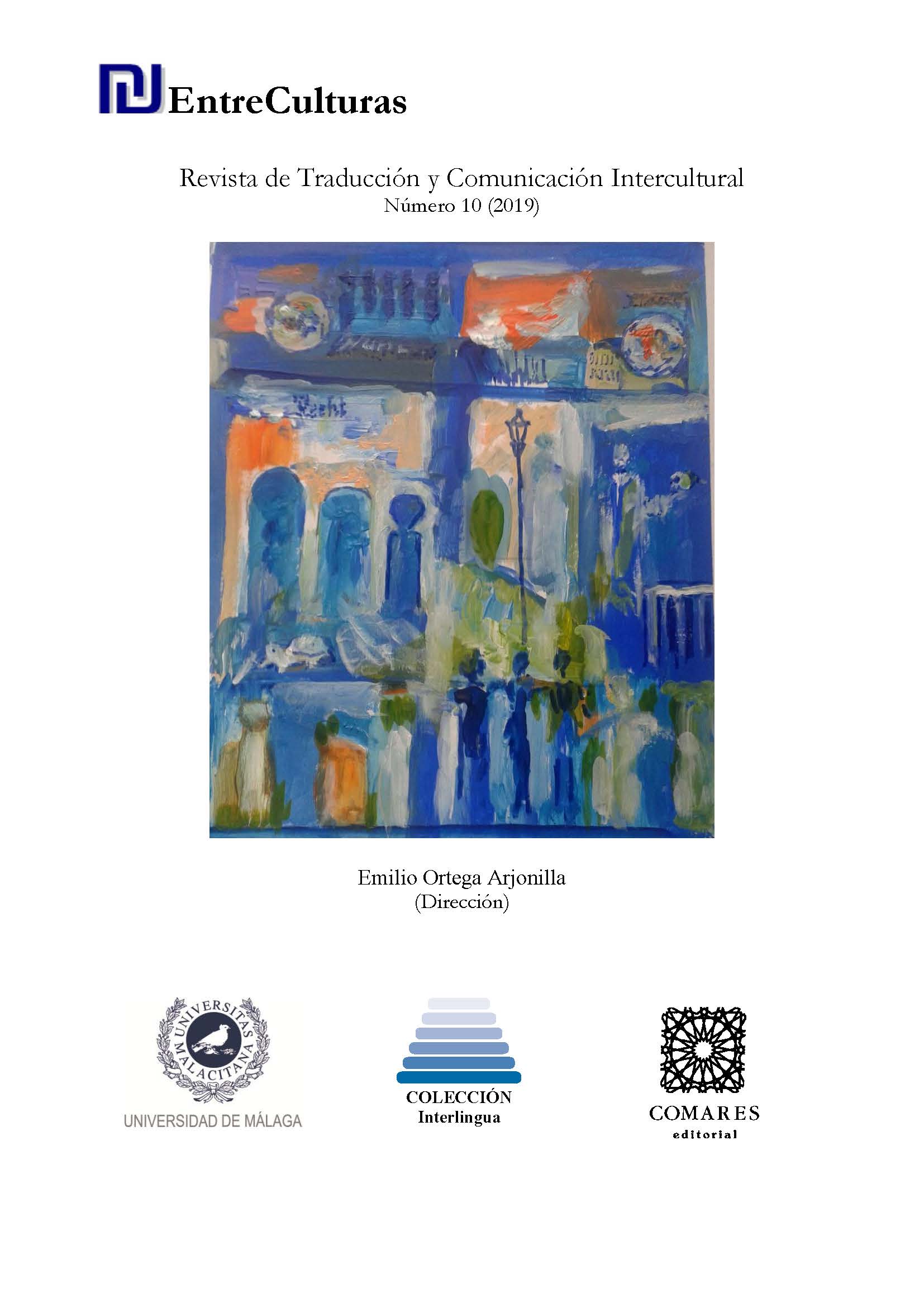The importance of extra-linguistic sub-competence in the analysis (FR-ES) of cultural expressions. A case study of the films L´ auberge espagnole and Qu´ est-ce qu´ on a fait au bon dieu?
DOI:
https://doi.org/10.24310/Entreculturasertci.vi10.12525Keywords:
Extralinguistic sub-competence, Culture, Translation problems, Translation techniques, Translation competence, ExpressionsAbstract
This article is about the importance of extralinguistic sub-competence in translation. Specifically, in the analysis of a series of expressions of the French films L'auberge espagnol and Qu'est-ce qu'on a fait au Bon Dieu? In first place, we go through various theories based on the translation competence and the different sub-competencies of the translation process, as well as on the connection between translation and culture and translation problems and techniques. In second place, we talk about the films. Then, we analyse the expressions that will serve as support to confirm the importance of the competences in translation (in particular, extralinguistic sub-competence) that differentiate a professional translator from the "mere" language connoisseurs. Finally, we present the conclusions.
Downloads
Metrics
References
Aubertot, A. y X. Rodríguez Rosell, (2009): À Donf !, Barcelona, Difusión, Centro de Investigación y Publicaciones de Idiomas, S.L.
Casagrande, J. (1997): “The Ends of Translation”, International Journal of American Linguistics, 24.4, 335-340.
Castillo García, Gema Soledad (2006): La (auto)traducción como mediación entre culturas. Alcalá de Henares, Universidad de Alcalá.
CNRTL [en línea] (2017) http://www.cnrtl.fr [consulta: 8 de mayo de 2017].
Costa i Vila, J. [en línea] (2014): “El entrañable racista”, El País, 19/12/2014, http://cultura.elpais.com/cultura/2014/12/18/actualidad/1418919403_123228.html. [consulta: 28 de marzo 2017].
Delisle, Jean (1993): La Traduction Raisonnée. Manuel d’initiation à la traduction professionnelle de l’anglais vers le français. Ottawa, Les Presses de l‘Université d‘Ottawa. Colección Pédagogie de la traduction.
FilmAffinity [en línea] (2017): “Dios mío, ¿pero qué te hemos hecho?”, http://www.filmaffinity.com/es/film357505.html. [consulta: 29 de marzo de 2017].
FilmAffinity [en línea] (2017): “Una casa de locos”, http://www.filmaffinity.com/es/film814400.html. [consulta: 29-03-2017].
Fundéu [en línea] (2017) http://www.fundeu.es. [consulta: 22 de marzo de 2017].
Hurtado Albir, Amparo (1996): La enseñanza de la traducción. Castellón de la Plana, Universitat Jaume I. Servei de Comunicació i Publicacions. Colección Estudis sobre la traducció.
Hurtado Albir, Amparo (2011): Traducción y traductología. Introducción a la traductología. Madrid, Ediciones Cátedra.
Katan, David (1999): Translating Cultures. And introduction for Translators, Interpreters and Mediators. Ámsterdam, Rodopi.
Luque Nadal, L. (2009): “Los culturemas: ¿unidades lingüísticas, ideolñgicas o culturales?”, Language Design II, 93-120.
Margot, Jean-Claude (1979): Traduire sans traduire. Suiza, Éditions l‘Âge d‘Homme.
Newmark, Peter (1992/1988): Manual de Traducción. Madrid, Cátedra.
Nida, E. y C. Taber, (1986): La traducción: teoría y práctica. Madrid, Ediciones Cristiandad. Nord, C. (1994): “It‘s a tea-time in Wonderland. Culture-makers in fictional texts”, en H. Pürschel (ed.), Intercultural Communication., 523-538.
Nord, C. (2009): “El funcionalismo en la enseñanza de traduccion”, Mutatis Mutandis, 2, 3-35.
Nord, C. (2010): “Las funciones comunicativas en el proceso de traducción: un modelo cuatrifuncional”, Nucleo, 27, 239-255.
Nord, Christiane (1991/1988): Text analysis in Traslation. Ámsterdam, Rodopi.
PACTE (2001): “La competencia traductora y su adquisici´ón”, Quaderns. Revista de Traducció, 6, 39-45.
PACTE (2003): “Building a Translation Competence Model”, en F. Alves (ed.): Triangulating Translation: Perspectives in Process Oriented Research. Ámsterdam, John Benjamins.
PACTE (2011): “Results of the Validation of the PACTE Translation Competence Model: Tanslation Problems and Translation Competence”, en A. Hild (ed.): Methods and Strategies of Process Research: Integrative Approaches in Translation Studies. Ámsterdam, John Benjamins.
Rey, A. y S. Chantreau, (2007): Dictionnaire des expressions et locutions. París, Dictionnaires LE ROBERT. Colección Les Usuels.
Rivero, R. (2016): “Cien años del señor del mambo”, El Mundo, 13/12/2016, [en línea]: http://www.elmundo.es/cultura/2016/12/13/584fb41ee2704e00198b45d2.html. [consulta: 17 de mayo de2017].
Service-Public.fr, LE SITE OFFICIEL DE L’ ADMINISTRATION FRANÇAISE [en línea] (2017): https://www.service-public.fr/particuliers/vosdroits/N144. [consulta: 10 de mayo de 2017].
Vlakhov, S. y S. Florin, (1970): “Neperevodimoe v perevode: realii”, Masterstvo perevoda¸ Moscú, Sovetskii pisatel, 432-456.
Downloads
Published
How to Cite
Issue
Section
License
All contents published in Entre culturas. Revista de traducción y comunicación intercultural are protected under the Creative Commons Attribution-NonCommercial-ShareAlike 4.0 International (CC BY-NC-SA 4.0) license. All about this license is available in the following link: <http://creativecommons.org/licenses/by-nc-sa/4.0>
Users can copy, use, redistribute, share and exhibit publicly as long as:
- The original source and authorship of the material are cited (Journal, Publisher and URL of the work).
- It is not used for comercial purposes.
- The existence of the license and its especifications are mentioned.
There are two sets of authors’ rights: moral and property rights. Moral rights are perpetual prerogatives, unrenounceable, not-transferable, unalienable, imprescriptible and inembargable. According to authors’ rights legislation, Entreculturas. Revista de traducción y comunicación intercultural recognizes and respects authors moral rights, as well as the ownership of property rights, which will be transferred to University of Malaga in open access. The property rights are referred to the benefits that are gained by the use or the dissemination of works. Entreculturas. Revista de traducción y comunicación intercultural is published in an open access form and it is exclusively licenced by any means for doing or authorising distribution, dissemination, reproduction, , adaptation, translation or arrangement of works.
Authors are responsable for obtaining the necessary permission to use copyrighted images.





7.png)
